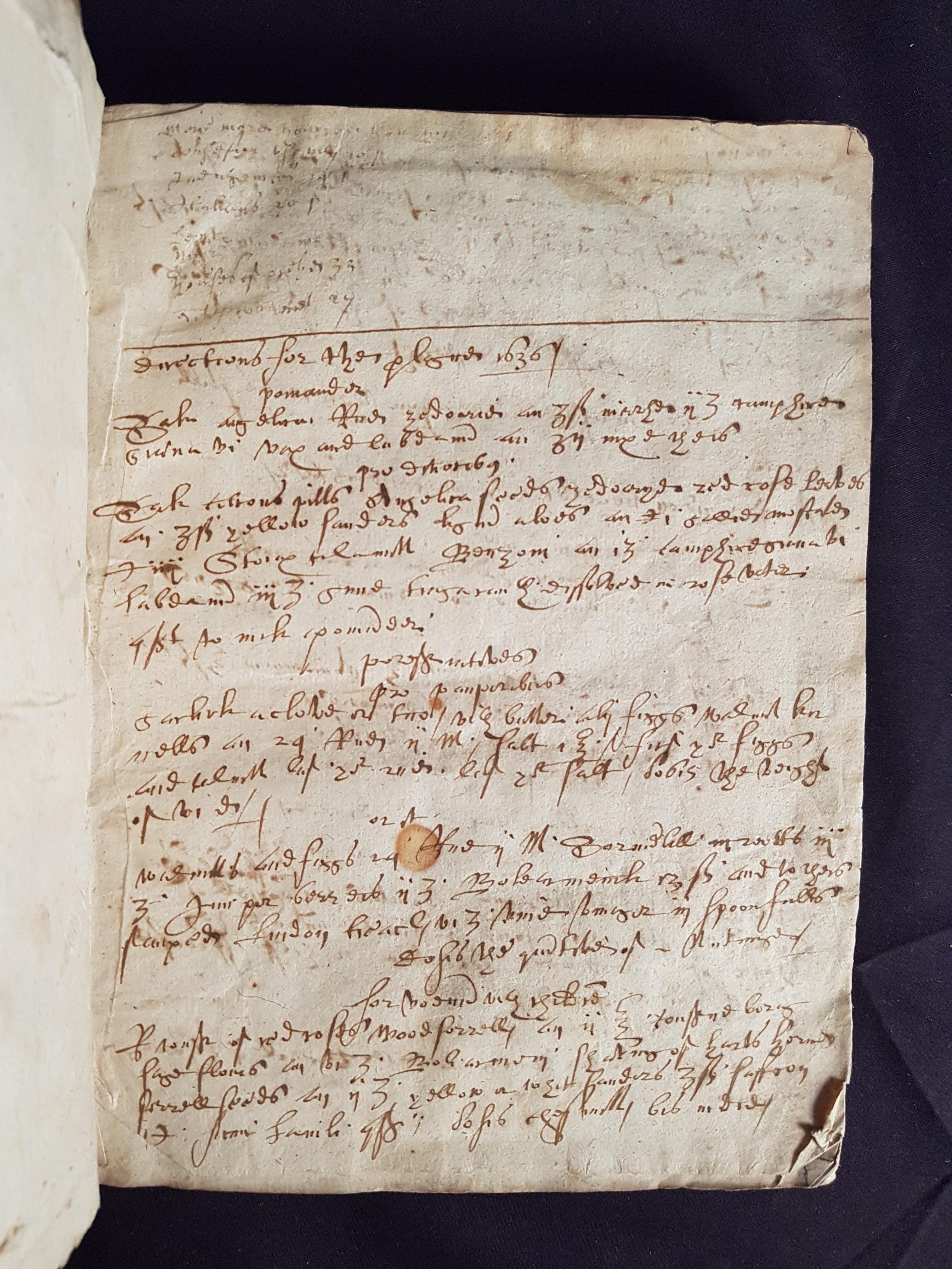SANDYS, Edwin
Europæ speculum. Or, A vievv or survey of the state of religion in the vvesterne parts of the world.
London, printed by T. Cotes, for Michael Sparke, 1632£2,250.00
4to. [viii], 248. + , a-h , I , k-2h . (quires d & h incorrectly folded so partly misplaced) “At end of text: From Paris. IX. Aprill. 1599. Copied out by the authors originall, and finished, 2. Octob. An. M.DC.XIII.” ESTC. Roman letter, some Gothic and Greek. Small woodcut device on t-p, woodcut initials, typographical and woodcut headpieces, a few contemporary ms annotations, interesting medical recipes relating to the plague of 1636 in a contemporary hand on front free endpapers. Light age yellowing, small oil? staining to upper blank margin of first 30 or so leaves, the odd thumb mark, worm pin-holes in upper blank margin of a few leaves. A very good, unsophisticated copy, well margined, in contemporary limp English vellum, remains of ties, ms title to spine.
Second complete edition of Sir Edwin Sandys’ (1561-1629) seminal work on the state of Christianity in Europe. The result of a three-year tour around the continent, undertaken with Sandys’ companion George Cranmer in 1593, the Europae Speculum professes to examine the condition of the Reformed Churches of mainland Europe, possibly with a view to suggesting some form of re-unification; in fact, Sandys never reaches the topic in this work, but dedicates nearly three quarters of the book to detailed description and analysis of Roman Catholicism, “enumerating their beliefs, practices, government, and the means used to increase power, frequently finding merit in their customs and ideas while disapproving of the way in which these were put into practice”, Mary Ellen Henley, “Sir Edwin Sandy’s Europae Speculum: a critical edition”.
Sandys writes that the French Catholics were most ripe for a reunification with Protestantism; he believed that Italy would first have to abandon its predilection for popery and that Spain was a lost cause. “Europae Speculum is a fascinating work from a number of aspects. It is a highly sceptical, pragmatic work, apportioning praise and blame to aspects of Protestantism and Catholicism with equity and judiciousness before finally championing Hooker’s via media – indeed so finely poised is Europae Speculum that it appears to have been seen as a justification for both sides of the religious divide at different times. The pirated editions of 1605 were rapidly banned, in an action which was perhaps related to the government dislike of Sir Edwin’s behaviour during the Parliament of 1604, but more likely because of official disapproval of its moderate attitude towards Catholicism, or its proto-Arminianism: in 1629 another edition appeared, again without the author’s knowledge, with an anonymous preface which claimed it as a powerful attack on the Church of Rome, and on English Arminianism. At first appearance, it is likely to have been the moderate, conciliatory, and even appreciative tone of some of Sir Edwin’s remarks about Roman Catholicism which many English protestants .. would have found shocking.” James Ellison ‘George Sandys: Travel, Colonialism, and Tolerance in the Seventeenth Century’.
The work first appeared in 1599, in a number of manuscript copies; it was pirated anonymously in June 1605. The Gunpowder Plot of November that same year created strong anti-Catholic feeling; in response, the High Commission ordered that copies of the Europae Speculum be burnt, possibly at Sandys’ own request. The work proved popular in Europe: Paolo Sarpi, ‘that great Catholic supporter of Protestantism’, whom Sandys had met on his tour, translated it into Italian, and Hugo Grotius, ‘that great Protestant supporter of Catholicism’ (Trevor-Roper), read it in the French translation. Sandys died in October 1629, and it is unclear what hand he had in the production of the edition of 1629 (of which this a direct copy), much expanded from the 1605; his name does not appear on the title page, but does on +2. The author of its anonymous introduction claims that the 1605 was ‘but a spurious stolen Copie .. throughout most shamefully falsified & false printed’, and that the present edition is printed from ‘a perfect Copie, verbatim transcribed from the Authours original’. It was seventy pages longer.
Sir Edwin Sandys, second son of the Archbishop of York of the same name, had a long and successful career in British politics; he became an MP in 1589, holding various seats in parliament until three years before his death. He was knighted in 1603, and became High Sheriff of Kent in 1615. He is, however best remembered for his involvement in the Virginia Company; he was instrumental in the establishment of Jamestown, lent money interest-free to the Pilgrim Fathers and believed passionately in the creation of a permanent British colony in North America.
The contemporary notes on the fly are most interesting, containing recipes for remedies agains the plague, which was endemic in London and had broken out again in the year 1636, the date of these notes.
ESTC S116683. STC 21719; Lowndes only has the 1639 edition (VI, 2189). Alden 629/53. (1629 edn.) ‘There are several references to the Spanish colonies in the Americas.’In stock






